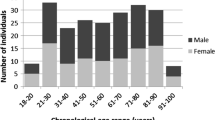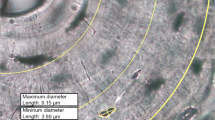Abstract
Histology is used to describe post-mortem bone alterations, trauma, pathology and age estimation and to separate human and non-human bones. Many scholars are however not familiar with the intricate and variable microstructure of bone, and due to the complex nature of some classification systems, bone histomorphology is often incorrectly described or identified. Little information is available on the histomorphology of non-human bones found in southern Africa, and therefore, the aim of this study was to describe the histomorphology of non-human species commonly found in southern Africa, namely, impala and monkeys, along with cat, dog, cow, sheep, equid and pig. Human femora were included for comparative purposes. The periosteal surface of femora was described and focussed only on the arrangements of vascular canals, primary osteons and secondary osteons. The results compared favourably to other studies and also added a histomorphological description of impala femora which consisted of primary vascular longitudinal bone tissue. A large degree of overlap and combinations of bone tissue types was observed, as well as evidence which allows animals from similar taxonomic orders to be grouped together. Primary vascular bone was primarily observed in artiodactyls (cow, pig, sheep and impala), while Haversian bone was recognised in carnivores (cat and dog), Perissodactyla (horses and donkeys) and primates. These differences can be used to exclude human from unknown bone fragments and also serve to caution investigators when using animal models to infer human bone tissue responses to thermal damage, ballistic trauma, etc., as bone tissue types different to that of human bone may respond differently.










Similar content being viewed by others

References
Hackett CJ (1981) Microscopical focal destruction (tunnels) in exhumed human bones. Med Sci Law 21:243–267
Jans MME, Nielsen-Marsh CM, Smith CI, Collins MJ, Kars H (2004) Characterisation of microbial attack on archaeological bone. J Archaeol Science 31:87–95
Hollund HI, Jans MME, Collins MJ, Kars H, Joosten I, Kars SM (2011) What happened here? Bone histology as a tool in decoding the postmortem histories of archaeological bone from castricum. The Netherlands Int J Osteoarchaeol. doi:10.1002/oa.1273
Bell LS (2012) Histotaphonomy. In: Crowder C, Stout S (eds) Bone histology. An anthropological perspective. CRC Press, Boca Raton, pp 241–251
Boyde A, Hendei P, Hende R, Maconnachie PE, Jones SJ (1990) Human cranial bone structure and the healing of cranial bone grafts: a study using backscattered electron imaging and confocal microscopy. Anat Embryology 181:235–251. doi:10.1007/BF00174618
De Boer HH, Aarents MJ, Maat GJR (2010) Staining ground sections of natural dry bone tissue for microscopy. Int J Osteoarchaeol. doi:10.1002/oa.1208
Bartelink EJ, Wiersema JM, Demaree RS (2001) Quantitative analysis of sharp-force trauma: an application of scanning electron microscopy in forensic anthropology. J Forensic Sci 46:1288–1293
Agnew AM, Bolte JH IV (2012) Bone fracture: biomechanics and risk. In: Crowder C, Stout S (eds) Bone histology. An anthropological perspective. CRC Press, Boca Raton, pp 221–240
Kerley ER (1965) The microscopic determination of age in human bone. Am J Phys Anthropol 23:149–163. doi:10.1002/ajpa.1330230215
Keough N, L’Abbé EN, Steyn M (2009) The evaluation of age-related histomorphometric variables in a cadaver sample of lower socioeconomic status: implications for estimating age at death. Forensic Sci Int 191:114.e1–114.e6. doi:10.1016/j.forsciint.2009.07.012
Streeter M (2012) Histological age-ate-death estimation. In: Crowder C, Stout S (eds) Bone histology. An anthropological perspective. CRC Press, Boca Raton, pp 135–152
Ortner DJ (2003) Identification of pathological conditions in human skeletal remains, 2nd edn. Academic, Amsterdam
Maat GJR (2004) Scurvy in adults and youngsters: the Dutch experience. A review of the history and pathology of a disregarded disease. Int J Osteoarchaeol 14:77–81. doi:10.1002/oa.708
Schultz M (2001) Paleohistopathology of bone: a new approach to the study of ancient diseases. Yrbk Phys Anthropol 44:106–108. doi:10.1002/ajpa.10024
Schultz M (2003) Light microscopic analysis in skeletal paleopathology. In: Ortner D (ed) Identification of pathological conditions in human skeletal remains, 2nd edn. Academic, Amsterdam
Schultz M, Parzinger H, Posdnjakov DV, Chikisheva TA, Schmidt-Schultz TH (2007) Oldest known case of metastasizing prostate carcinoma diagnosed in the skeleton of a 2,700-year-old Scythian King from Arzhan (Siberia, Russia). Int J Cancer 121:2591–2595. doi:10.1002/ijc.23073
Schultz M (2012) Light microscopic analysis of macerated pathologically changed bone. In: Crowder C, Stout S (eds) Bone histology. An anthropological perspective. CRC Press, Boca Raton, pp 253–296
Martiniaková M, Grosskopf B, Omelka R, Vondráková M, Bauerová M (2006) Differences among species in compact bone tissue microstructure of mammalian skeleton: use of a discriminant function analyses for species identification. J Forensic Sci 51:1235–1239. doi:10.1111/j.1556-4029.2006.00260.x
Martiniaková M, Grosskopf B, Vondráková M, Omelka R, Fabĭs M (2006) Differences in femoral compact bone tissue microscopic structure between adult cows (Bos taurus) and pigs (Sus scrofa domestics). Anat Histol Embryol 35:167–170. doi:10.1111/j.1439-0264.2005.00652.x
Cuijpers AGFM (2006) Histological identification of bone fragments in archaeology: telling humans apart from horses and cattle. Int J Osteoarchaeol 16:465–480. doi:10.1002/oa.848
Martiniaková M, Grosskopf B, Omelka R, Vondráková M, Bauerová M (2007) Histological analysis of ovine compact bone tissue. J Vet Med Sci 69:409–411. doi:10.1292/jvms.69.409
Martiniaková M, Grosskopf B, Omelka R, Dammers K, Vondráková M, Bauerová M (2007) Histological study of compact bone tissue in some mammals: a method for species determination. Int J Osteoarchaeol 17:82–90. doi:10.1002/oa.856
Hillier ML, Bell LS (2007) Differentiating human bone from animal bone: a review of histological methods. J Forensic Sci 52:249–263. doi:10.1111/j.1556-4029.2006.00368.x
Cattaneo C, Porta D, Gibelli D, Gamba C (2009) Histological determination of the human origin of bone fragments. J Forensic Sci 54:531–533. doi:10.1111/j.1556-4029.2009.01000.x
Enlow DH, Brown SO (1958) A comparative histological study of fossil and recent bone tissue, part III. Tex J Sci 10:187–230
Enlow DH (1966) An evaluation of the use of bone histology in forensic medicine and anthropology. In: Evans FG (ed) Studies on the anatomy and function of bone and joints. Springer, Heidelberg, pp 93–112
Enlow DH, Brown SO (1956) A comparative histological study of fossil and recent bone tissues, part I. Tex J Sci 7:405–443
Enlow DH, Brown SO (1957) A comparative histological study of fossil and recent bone tissues, part II. Tex J Sci 9:186–214
Locke M, Dean RL (2003) Vascular spaces in compact bone: a technique to correct a common misinterpretation of structure. Am Biol Teach 65:701–707
Mulhern DM, Ubelaker DH (2003) Histological examination of bone development in juvenile chimpanzees. Am J Phys Anthropol 122:127–133. doi:10.1002/ajpa.10294
Francillon-Vieillot H, de Buffrénil V, Castanet J, Géraudie J, Meunier FJ, Sire J, Zylberberg L, de Ricqlès A (1990) Microstructure and mineralization of vertebrate skeletal tissues. In: Carter JG (ed) Skeletal biomineralization: patterns, processes and evolutionary trends. Van Nostrand Reinhold, New York, pp 471–530
Greenle DM, Dunnell RC (2010) Identification of fragmentary bone from the Pacific. J Archaeol Sci 37:957–970
Locke M (2004) Structure of long bones in mammals. J Morphol 262:546–565. doi:10.1002/jmor.10282
Skinner JD, Chimimba CT (2005) The Mammals of the Southern African, 3rd edn. Cambridge University Press, Cape Town
Steyn M, Henneberg M (1996) Skeletal growth of children from the Iron Age site at K2 (South Africa). Am J Phys Anthropol 100:389–396
Maat GJR, Van den Bos RPM, Aarents MJ (2001) Manual preparation of ground sections for the microscopy of natural bone tissue: update and modification of Frost’s ‘rapid manual method’. Int J Osteoarchaeol 11:366–374. doi:10.1002/oa.578
Mulhern DM, Ubelaker DH (2001) Differences in osteon banding between human and nonhuman bone. J Forensic Sci 46:220–222
Crescimanno A, Stout SD (2011) Differentiating fragmented human and nonhuman long bone using osteon circularity. J Forensic Sci. doi:10.1111/j.1556-4029.2011.01973.x
Zedda M, Lepore G, Manca P, Chisu V, Farina V (2008) Comparative bone histology of adult horses (Equus caballus) and cows (Bos taurus). Anat Histol Embryol 37:442–445. doi:10.1111/j.1439-0264.2008.00878.x
Mulhern DM, Ubelaker DH (2012) Differentiating human from nonhuman bone microstructure. In: Crowder C, Stout S (eds) Bone histology. An anthropological perspective. CRC Press, Boca Raton, pp 109–134
Norman JE, Ashley MV (2000) Phylogenetics of Perissodactyla and tests of the molecular clock. J Mol Evol 50:11–21. doi:10.1007/s002399910002
Cuijpers S, Lauwerier RCGM (2008) Differentiating between bone fragments from horses and cattle: a histological identification method for archaeology. Environ Archaeol 13:165–179. doi:10.1179/174963108X343281
Mulhern DM, Ubelaker DH (2009) Bone microstructure in juvenile chimpanzees. Am J Phys Anthropol 140:368–375. doi:10.1002/ajpa.20959
Burr DB (1992) Estimated intracortical bone turnover in the femur of growing macaques: Implications for their use as models in skeletal pathology. Anat Rec 232:180–189. doi:10.1002/ar.1092320203
Acknowledgments
The authors would like to thank the Department of Anatomy (University of Pretoria) for permission to sample skeletal remains as well as Mr De Villiers from the Faculty of Veterinary Sciences (University of Pretoria) for the donation and maceration of non-human remains. We wish to acknowledge the efforts of Mr Botha, Mr Van der Merwe and Mr Hall from the Microanalysis Laboratory (University of Pretoria), Mr Marakalla from the Department of Anatomy (University of Pretoria) and also Mr du Plessis (University of the Witwatersrand) for their assistance. This research was supported by NAVKOM as well as the National Research Foundation (NRF) of South Africa which supports the research conducted by M Steyn and EN L’Abbé. Any opinions, findings and conclusions or recommendations expressed in the material are those of the authors and therefore the NRF does not accept any liability in regard thereto.
Author information
Authors and Affiliations
Corresponding author
Rights and permissions
About this article
Cite this article
Brits, D., Steyn, M. & L´Abbé, E.N. A histomorphological analysis of human and non-human femora. Int J Legal Med 128, 369–377 (2014). https://doi.org/10.1007/s00414-013-0854-3
Received:
Accepted:
Published:
Issue Date:
DOI: https://doi.org/10.1007/s00414-013-0854-3



